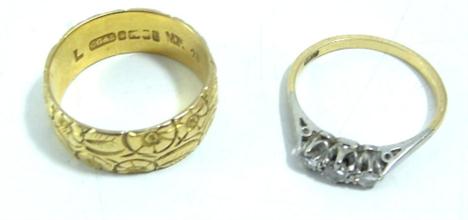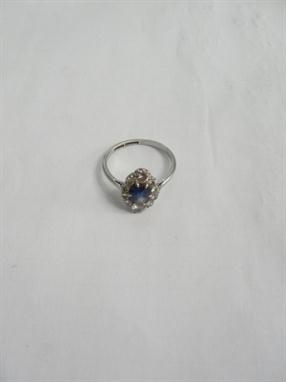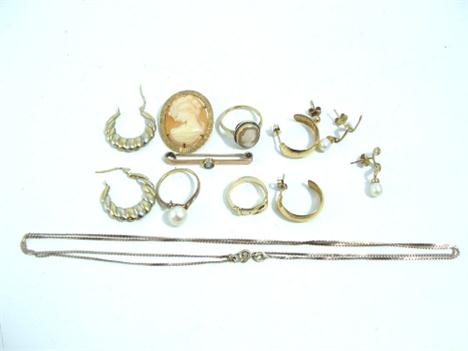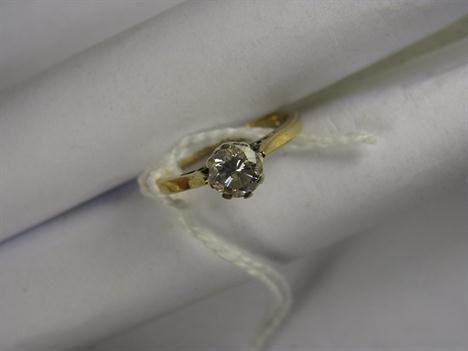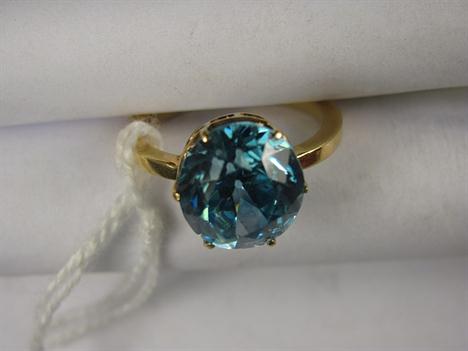We found 1087795 price guide item(s) matching your search
There are 1087795 lots that match your search criteria. Subscribe now to get instant access to the full price guide service.
Click here to subscribe- List
- Grid
-
1087795 item(s)/page
A good 19th century nickel plated open face 1-hundredth second timer by Charles Frodsham, three quarter plate movement with similar escapement, small three armed balance wound by a fixed key on back, the outer ring of the silvered dial calibrated for sweep seconds, with a single subsidiary dial indicating 1-hundredth seconds, signed Cha Frodsham, 27 South Molton Street, London, no.09732, the case back marked with The Ordnance broad arrow, diameter 64mm (over wound and currently not functioning) (Illustrated).
Scarce 1906 South America white metal rugby medal: the obverse is finely embossed with a rugby match scene and stamped with makers name to the border and on the reverse engraved Copa Compostelana Santiago – 1906 c/w suspension ring – overall 1.25"dia Illus.
Fine Vic white metal tennis propelling pencil made by Sampson Mordan & Co c1890 – in the form of a tilted racket c/w wire mesh stringing, collar, suspension ring and engraved with the maker`s details to the handle together with Vic Reg mark – overall 2.75". Note: see Everitt "Racket Sports Collectibles" p286
BRONNIKOV, FEODOR 1827-1902 Abandoned. The Vatican and Sin signed, inscribed "Rome" and dated 1872 Oil on canvas, 88 by 114 cm. Authenticity has been confirmed by the expert V. Petrov.The picture Abandoned. The Vatican and Sin is an autograph copy of one of the best-known compositions of Feodor Bronnikov, a history painter popular in the last third of the 19th century. Painted in Rome in 1872, it is a splendid example of the genre based on themes relating to the Eternal City. Bronnikov, following the classical canons, composes his painting like a stage set, on which he places his heroine in a striking and expressive position. The artist, always scrupulously accurate in his handling of detail, meticulously delineates the masonry of the parapet, the flare of distant fireworks, the ring on the heroine’s finger and her white cuffs. Beneath a surface restraint and sobriety in the portrayal, much is hidden in this painting, stemming from the contrast at the heart of this dramatic situation. Both in the technique used and in the treatment of the subject, we can detect a curious fusion of the academic tradition with the aesthetics and themes of the Itinerants. For when Bronnikov graduated from the Imperial Academy of Arts, he left Russia in 1854 on a study placement and then spent the rest of his life in Rome, rarely visiting Russia. Only in 1863 did he travel to St Petersburg, to present to the selection board of the Academy a large painting on a subject from Roman history, The Quaestor Reading the Death Sentence to Senator Thrasea Paetus for which he was named Professor of history painting. However, having arrived in Russia via an academic route, Bronnikov was quick to pick up new "populist" tendencies in the art of his native land. The artist became close to the Itinerants and, under their influence, felt an urge to do social good via his art. In his paintings a taste became apparent for portraying life in the lower strata of society, for themes and motifs "laying bare the festering sores of contemporary life". But unlike the Russian colleagues in his studio, Roman sybarite Bronnikov had lost his basis in Russian life and could not develop such themes, instead settling for "Italian" subjects. So he painted a series of genre pictures: Poor Family Being Driven from Their Lodging, An Old Beggar, Golden Wedding Anniversary, Distribution of Food in Front of the Monastery Gates, Sick Man Outside a Catholic Monastery, Artists in a Rich Man’s Parlour and Abandoned. The Russian critics, understandably, thought that Bronnikov belonged "to the earlier, `idealist` school, which holds back this artist, a sincere lover of justice, from portraying the unsavoury traits of his subject". But it was precisely that academic prettiness and a certain pathos and sentimentality, not at all detrimental to an understanding of the "unsavoury position" of his heroes, which allowed Bronnikov to create his own type of genre painting "on the topics of the day". Soon Bronnikov was admitted to the Society of Itinerant Art Exhibitions. From 1873 he showed his works at exhibitions in Moscow, St Petersburg, Kiev etc, alongside the greatest Russian masters. Bronnikov even painted an autograph copy of our painting, Abandoned. The Vatican and Sin, dated 1873, specially for the Society’s third exhibition. Reproduced in the exhibition catalogue, it made a great impression on his contemporaries and was soon bought by the mayor of Irkutsk, Vladimir Platonovich Sukachev. It is now housed in the Irkutsk Museum of Art which bears his name. As for the present, earlier version of this composition, its history is most probably associated with art collections in the West. At least, according to the Brockhaus and Efron Encyclopaedic Dictionary, "most of Bronnikov’s works are in Russia, but many have also been acquired by connoisseurs in England, America, Hungary, Italy and Denmark. Among his last works, Abandoned is worthy of note. This painting is owned by the Queen of Denmark".
Pakistan, Independence Medal 1947 (24) - named (9); unnamed (15), some with bent suspensions; 1939-45 Star (3) one with bent ring; another lacking ring; Burma Star (4) one lacking ring; Defence Medal (4); India Service Medal (6) one with slack and bent suspension, all unnamed, no ribbon, contact marks, good fine and better (41) £60-80
The Sovereign and Illustrious Order of St. John of Jerusalem: Anglia, an attractive breast badge of a Knight of Justice, of the period 1858-72, probably by Phillips Bros. & Sons, Cockspur St., London, 68mm x 40mm., gold and enamelled both sides, embellished in the angles with uniface unicorns and crowned lions, with a high relief crown hinged to the two uppermost points, this surmounted by an orb bearing an eight-pointed star and with a ‘rope’ ring suspension, crown reverse lightly inscribed, ‘1718’, with black ribbon and rosette and a gold stick-pin for attachment, extremely fine and rare £700-800
Three: Commissioned Boatman William Wick, H.M. Coast Guard, late Petty Officer, Royal Navy Crimea 1854-56, no clasp, unnamed; Turkish Crimea 1855, British issue, unnamed, plugged and fitted with swivel ring suspension; Tayleur Fund Medal, silver, reverse inscribed, ‘To William Wick, H.M.S. Ajax for Distinguished Gallantry in saving of life at Kingstown 9th Feby. 1861. The Rt. Honble. Lord Talbot de Malahide Chairman’, last with some edge bruising and contact marks, good very fine; others better (3) £500-600 ‘In a terrific gale on Feb 9, 1861 several vessels were wrecked at Kingstown Harbour. One of them the Neptune struck on the east pier, and a line was thrown over her from the mortar, but the only man remaining on board was unable to secure it. Captain Boyd and several men belonging to the Ajax assisted the Inspecting Commander of Coastguard in endeavouring to save life, and while attempting to get a line on board Neptune a tremendous wave swept the glacis on which they were standing, and washed them into the sea. Captain Boyd and five of his men were unfortunately drowned’. (Ref: N.A. BT 261/1). William Wick was born in Windham, Norfolk, on 20 May 1835. He served as an Ordinary Seaman aboard the Spiteful, July 1854-May 1857, for which he was awarded medals for the Crimean War. After service on the Conway, July 1857-January 1858, he served on the Ajax, firstly as an Able Seaman/Leading Seaman, February 1858-November 1861 and then as Coxswain of the Pinnace, November 1861-October 1862. It was during his service on the Ajax that he assisted in the rescue at Kingstown, Dublin (above). Wick attained the rank of Petty Officer 1st Class on the Hecate in April 1878. He served as a Commissioned Boatman in the Coast Guard, August 1878-September 1884, being based at Baldoyle, Co. Dublin. The rescue at Kingstown, 9 February 1861, was the first occasion for which the Tayleur Fund Medal was awarded; two gold and 22 silver medals were awarded for the incident; see L.S.A.R.S. Journal No. 22, p.4-49, for a full account of the medal and rescue. With copied service papers and a modern photograph of the memorial statue to Captain Boyd of the Neptune.
Shropshire Society in London Life Saving Medal, Captain Matthew Webb left, reverse inscribed, ‘Presented to The Designer upon the Institution of the Decoration’, edge inscribed (Captain Adrian Jones, M.V.O., R.B.S. President) 51mm., silver, with ring suspension and ribbon, with silver brooch bar, extremely fine £300-400 Adrian Jones was born on 9 February 1845, the fourth son of James Brookholding Jones of Ludlow. After being educated at Ludlow Grammar School he served 23 years in the Army - in the 3rd Hussars, Queen’s Bays and 2nd Life Guards - seeing service in the Abyssinian War 1868 (medal); the 1st Boer War 1881, and the Nile Expedition (medal and star). A noted Sculptor, he was awarded the M.V.O. 4th Class in 1907 on the occasion of the unveiling of a statue of the Duke of Cambridge at Whitehall for which he was responsible. His other works include the Royal Marines Monument, St. James’s Park, the Carabineers’ Memorial, Chelsea Embankment, and the Peace Quadriga on Constitutional Hill Arch. In 1935 he was awarded the Gold Medal of the Royal Society of British Sculptors. Captain Jones died on 24 January 1938.
Chester Royal Infirmary Nursing Medal, obverse: John Haygarth F.R.S.; reverse inscribed (name and date engraved) ‘Awarded by the Governors to Nurse Vera E. Davies, 1933’, 36mm., silver, hallmarks for Birmingham 1933, pierced for suspension, some edge bruising; Guy’s Hospital Nursing Medal, obverse: Thomas Guy; reverse inscribed (name engraved) ‘To Kathleen O. Turner Certificated Nurse on completing seven years service’, 32mm., silver, with pin-fitting, edge bruise, fine; St. George’s in the East Infirmary Nurse Training Medal, obverse: St. George and the Dragon; reverse engraved, ‘Ellen Humphreys, 9th July 1917.’ 39mm., silver, ring suspension, good very fine except where stated (3) £70-90
Derby Boer War Tribute Medal 1901-02, silver, six pointed star, 43 x 30mm, with gilt central medallion bearing a stag encircled by a fence, and the arms decorated by a fleur de lis, the reverse inscribed, ‘Pte. F. Winfield’, with ring suspension, ref. Hibbard A. 10, jeweller’s mark to reverse, good very fine, rare £200-250
-
1087795 item(s)/page







